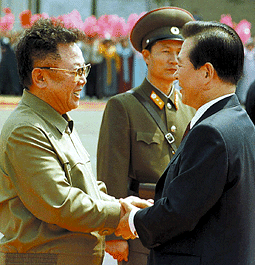Ruthless Leader of North Korea Is Dead
Monday, December 19th, 2011Dec. 19, 2011
People openly wept on the streets of Pyongyang, capital of North Korea, upon hearing the news that their “Dear Leader,” Kim Jong-il, had died. The official news agency KCNA announced that Kim suffered a heart attack and died on December 17 at age 69. A tearful state media announcer confirmed that one of Kim’s sons, Kim Jong-un, is the “great successor” behind whom North Koreans should unite.

Kim Jong-il (left) greets then-President Kim Dae-jung of South Korea in 2000. © AP/Wide World
Fearing that Kim’s death could destabilize North Korea, the government of South Korea put its armed forces on high alert and declared that the country was on a crisis footing. In Tokyo, the Japanese government convened a special security meeting. According South Korea, the North test-fired a short-range guided missile prior to the announcement of Kim’s death. North Korea and South Korea remain technically at war 58 years after the Korean War ended on July 27, 1953. A permanent peace treaty between South Korea and North Korea has never been signed, and the United States has nearly 30,000 troops stationed in South Korea to discourage hostilities between the North and South.
Kim Jong-il succeeded his father, Kim Il-sung, who died in 1994. Kim Il-sung had, with the support of the Soviet Union, established North Korea as a Communist state in 1948, and he was its first leader.
Although the North Korean public was told the Kim Jong-il died of “physical and mental overwork,” he was known to be extremely fond of French brandy, gourmet food, and movies. He was said to have had a collection of 20,000 films. Under Kim Jong-il’s rule, an estimated 1 million North Koreans starved to death in the 1990′s because of famine. During this period, Kim achieved his greatest ambition, arming the nation with nuclear weapons. North Korea has long maintained one of the world’s largest standing armies–1 million troops–which were fed and maintained at the expense of the rest of the population. In 2011, North Korea continued to have chronic food shortages.
Additional World Book articles
- Back in Time 1948 (Korea)
- Back in Time 1950 (Korea)
- Back in Time 1951 (Korea)
- Back in Time 1952 (Korean War)
- Back in Time 1953 (Korean War)
- Back in Time 1994 (Korea)
- Back in Time 2010 (Korea)


